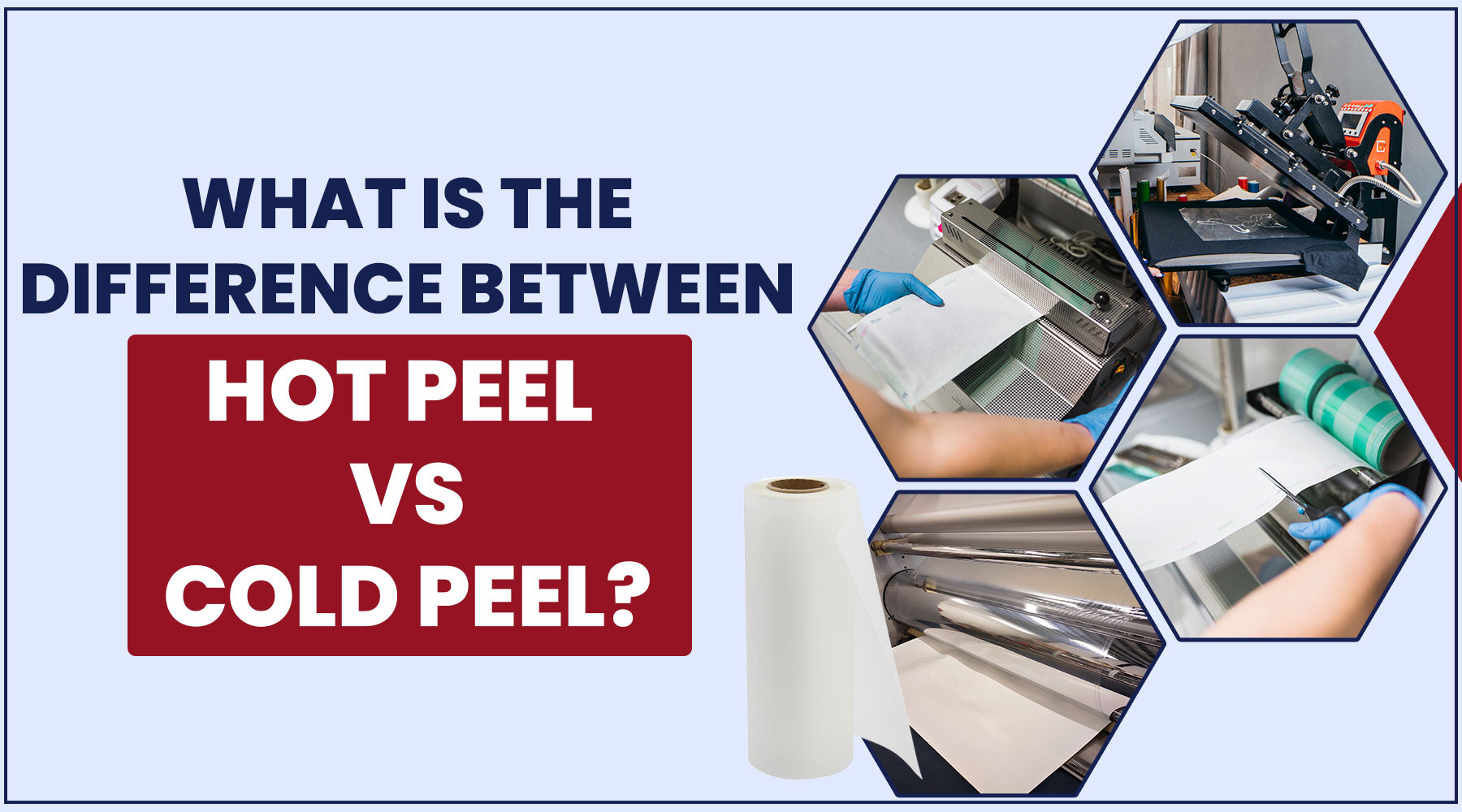When working with printable heat transfer vinyl and films, you’ll soon encounter the terms “hot peel” and “cold peel” used to describe application and removal methods. But what do they actually mean and what’s the difference in practice?
Read on as we define these two transfer processes to see how hot peel vs cold peel DTF film stacks up across crucial criteria from efficiency to end results.
What is DTF Film?
DTF stands for “Direct to Film” and refers to specialty printable heat transfer vinyl materials that can be run through regular inkjet or laser printers to create customized image transfers. DTF comes on a thin carrier backing for stability during printing and cutting, along with a release layer that detaches from the transfer medium when heat is applied during the transfer process.
Also Read: The Ultimate Guide to Creating Stunning Graphic Prints
Difference Between Hot Peel Film and Cold Peel Film
The main variance between these transfer films lies in the method used to detach the backing layer after heat-pressing the design onto the target surface like a t-shirt.
Main Component of DTF Film: Hot Peel vs. Cold Peel
The transfer vinyl or film itself has the same base components in hot and cold peel versions. The difference lies in the release layer formulation which determines how it reacts to heat.

Hot peel DTF has a release layer that becomes more adhesive when hot, bonding tightly to the transfer medium below it. Cold peel DTF’s release stays inert when heated, keeping a lower bond to the layer underneath.
Hot Peel Film vs. Cold Peel Film: Different Pressing Temperature and Processing Time
Due to the different release layer properties, hot peel and cold peel DTF require different pressing parameters:
- Hot Peel – Applied at ~330-375°F for 15 seconds, peeled hot
- Cold Peel – Applied at ~320-350°F for 10-15 seconds, peeled cold
So hot peel needs slightly higher heat and longer pressing time, but does enable immediate peeling right after removing from the heat press while still hot.
Hot Peel Film vs. Cold Peel Film: Application Materials
You’ll also need separate non-stick application pads or silicone sheets for hot peel versus cold peel, suited to the required peel temperature and adhesive strength. Reusing the same sheet between both methods risks tearing off bits of still-warm transfers. Dedicated sheets prevent this issue.
Which costs Higher: Hot Peel Film or Cold Peel Film?
Both varieties have become similarly priced recently thanks to wider adoption. Initially, hot peel DTF was slightly more costly due to the specialized release layer. But now with popularity of printable transfers booming, mass production has created pricing parity. You may find small cost differences, but most suppliers charge in the same ballpark.
Efficiency of Hot Peel Film and Cold Peel Film
Peeling the DTF carrier while still hot allows for faster single-step application ideal for heat-pressing multiple shirts in quick succession like event merch or team uniforms. No waiting around for transfers to fully cool first.
However for occasional personalization and custom one-off prints, cold peel works fine. Just account for the extra few minutes of cooling time per shirt when scheduling your project.

Different Washing Fastness Between Hot Peel and Cold Peel Film
When evaluating wash durability over repeated launderings, cold peel DTF often outperforms hot peel vinyl with longer-lasting decals, less chance of cracking or peeling, and better color retention.
The reason lies in how strong the adhesive bond forms to the fabric itself. Hot peel’s ultra-sticky release layer can bond too aggressively to uneven textured fabrics. Cold DTF adheres a bit gentler, allowing more flexibility in the transfer film itself to move with fabric instead of rigidly adhering then cracking over time.
Hot Peel vs. Cold Peel Film, which is Better?
Now we’ve extensively compared criteria for these two transfer processes from setup to efficiency to longevity. So which DTF wins the battle?
While higher initial adhesion gives hot peel DTF an edge for speedy pressing, cold peel vinyl lasts longer through washing cycles. Ultimately the answer depends mainly on your specific application.
For frequent batch production like custom t-shirt businesses, events companies and sports teams, hot peel offers faster workflow. The added durability of cold peel holds less relevance if shirts get retired after a season.
But for personalized gifts, apparel and decor meant to last years rather than weeks like family reunion keepsakes or customized home decor, opt for cold peel DTF. The extra effort pays off long-term via better quality and longevity compared to hot peel.
Also Read: Different Types of Shirt Printing: A Comprehensive Guide
What Are The Other DTF Film Types from Different Categorization?
Besides the hot and cold distinction, DTF transfer films also come in a few other varieties:
- Eco-Solvent DTF – Printed with solvent inkjet printers
- Latex DTF– Formulated for latex ink printers
- Laser DTF – For color or monochrome laser printers
There are also specialty metallic foils, flocks, glitters and more - far too many to list! As DTF continues gaining popularity for custom merch, expect even more options soon.
Conclusion
In the hot peel vs cold peel battle, both direct-to-film transfer methods have strengths in terms of processing efficiency versus wash durability. Hot peel DTF allows faster batch production while cold peel better survives repeated laundering over the long term. Let your specific application drive the decision between these two effective transfer films. And remember - you can always order samples to evaluate hands-on before investing in large rolls.

Get your DTF Transfer Sheet Today, & Try It Yourself!
Want to get hands-on comparing hot versus cold peel DTF? https://www.dtfnc.com/ and we’ll send free samples so you can press test prints at home! Discover first-hand the differences in application and performance. See if you can even tell finished hot and cold peel prints apart visually.
Also Read: Everything you need to know: Heat Transfer Designs Wholesale
FAQs
Do I peel sublimation hot or cold?
Sublimation transfers use heat to infuse fabric dyes rather than a film layer with adhesive. So there is no peel step - the printed transfer paper itself disappears upon pressing.
How do you know if vinyl is cold or hot peel?
Check product details from the supplier, as application temperature and times differ. If unspecified, 320°F for 10 seconds is likely cold peel while over 325°F for 15+ seconds indicates hot peel DTF.
What is a cold peel?
Cold peel requires you to press the DTF vinyl then wait for it to fully cool to room temperature before removing the backing, typically 5+ minutes. The transfer stays bonded in place while cooling.
What is a hot peel transfer?
Hot peel DTF can be immediately lifted off the item as soon as you remove it from the heating press, thanks to a sticky release layer that adheres strongly while hot but detaches easily from the cooled vinyl below.








